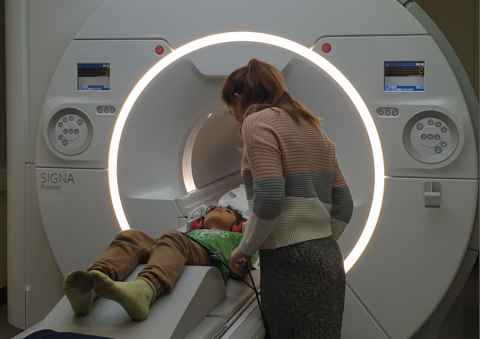Tairāwhiti Study – World-first roadmap for imaging and modelling child physiology
14 March 2023
Using cutting-edge MRI and modelling technology to understand child health.

How do children’s brains work and how do their bodies move? For millennia, medicine has often viewed children as adults in miniature – but this may not be so.
In a world-first, researchers from the Mātai Medical Research Institute (Mātai) and the Auckland Bioengineering Institute (ABI) at Waipapa Taumata Rau, University of Auckland have created a roadmap to mimic and analyse the structure and function of children’s brains, hearts, lungs and musculoskeletal systems. The models developed from this work may pave the way to benchmark normal paediatric structure and function enabling more accurate diagnoses and tailored treatment for children in New Zealand.
Around 30 scientists have honed techniques to create accurate physiological models of children’s organs and systems by combining novel super-fast Magnetic Resonance Image (MRI) sequencing, newly defined protocols on how best to undertake MRI scans with children, and serious number crunching from advanced computational modelling.
Dr Haribalan Kumar, Mātai Research Engineer and GE Healthcare Clinical Scientist says scanning “head to toe — in the same session — for the same child” is a world first.
While similar imaging studies have explored adult organs, paediatric work sets additional challenges. “MRI scans require a person to lay very still or hold their breath for a long time. Fidgeting, shorter attention spans, anxiety and the general unpredictable nature of kids can become important compliance issues.”
Researchers worked with 30 children, aged seven to 12 years old, from the Tairāwhiti-Gisborne district in New Zealand during the study. Children learnt about their brains and other organ systems, used relaxation techniques and ‘in-scan’ entertainment. They also received encouragement and support from their wider whānau to make participation a more successful and interesting process.
Dr Kumar clarifies that this is not a “quick scan over the entire body” but separate detailed imaging of specific body systems in one scan session. “The distinction is important.”
Dedicated hardware and software is needed for separate imaging of each of the different body systems: heart, lung, brain and muscular-skeletal systems. From there, bioengineers from ABI use multiple customised organ-specific algorithms to translate the scan images into quantitative information. These huge data sets are then manipulated to create physiologically accurate models of the organs.
“This integration of advanced image processing tightly coupled with unique computational modelling is a pioneering leap for field of paediatrics.”
This pilot study will inform the larger Tairāwhiti Study, which plans to establish normative imaging and modelling databases that can be used to improve understanding of the human body in health and disease.
Leigh Potter, Mātai Chief Operating Officer and project community lead says “Population-based imaging studies such as the Tairāwhiti study will underpin the next generation of advances in personalised and predictive medicine. Together, the work of the scientists and whānau across Tairāwhiti provides us with a roadmap to build predictive tools and personalised paediatric medicine.”
Over the coming months scientists will continue to analyse data gathered from the scans to uncover new insights of paediatric brain, cardiac, bone, lung and muscle funtion.
Link to paper: Frontiers in Physiology, “Roadmap for an imaging-modelling paediatric study in rural NZ”
Media contacts:
For commentary from Mātai Medical Research Institute
Jeanette Lepper, Head of Development
j.lepper@matai.org.nz 027 379 0170
For commentary from the Auckland Biotechnical Institute, University of Auckland
Megan Fowlie, Media advisor
megan.fowlie@auckland.ac.nz 022 301 0334